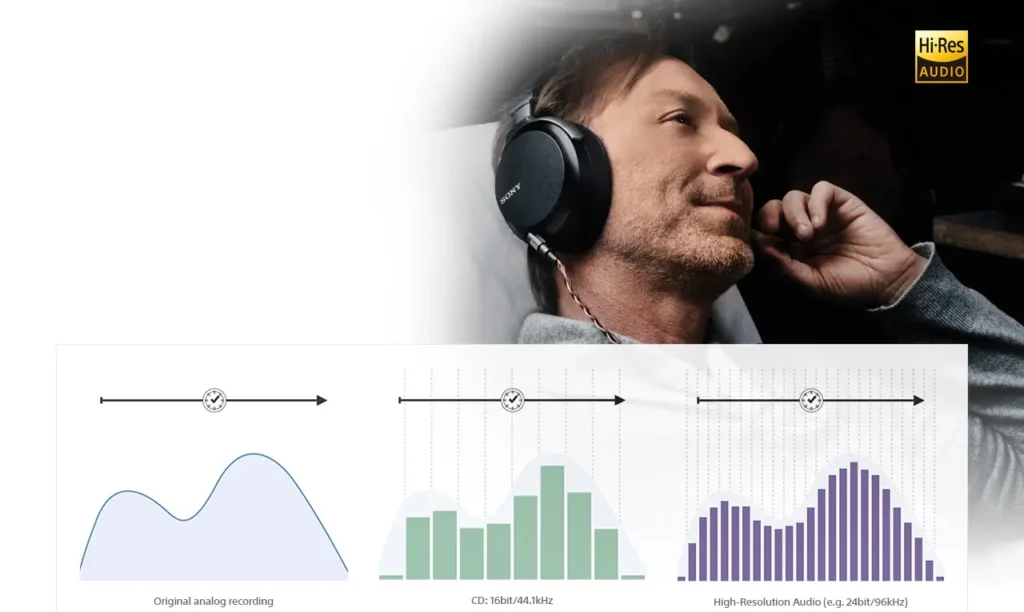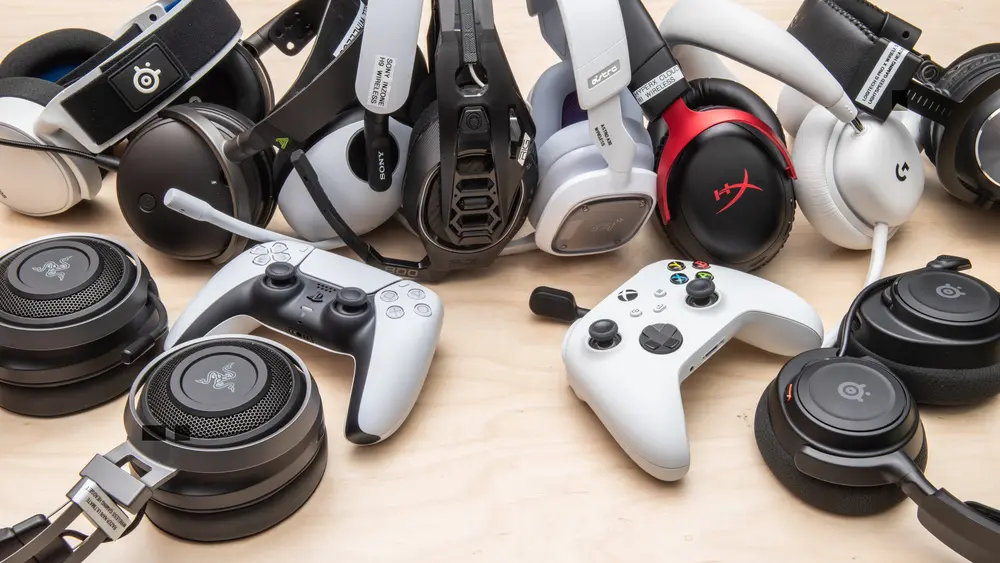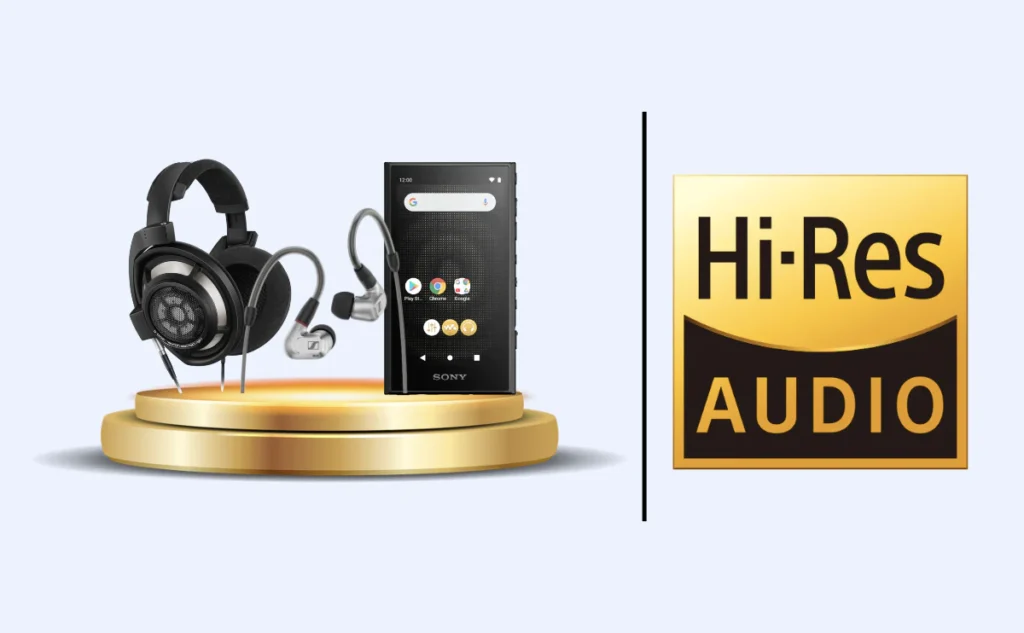Hi‑Res Audio is just a short way of saying high-resolution audio. It means the audio has more detail than what you’d get from a standard CD. A regular CD has a resolution of 16‑bit at 44.1kHz. Hi‑Res usually starts at 24‑bit and goes up to 96kHz or higher.
That higher resolution gives the audio more headroom and more room to breathe. It also allows the finer parts of a recording to stay intact. Soft details, echoes, and the way instruments fade out all sound more natural when they aren’t chopped down to save space.
Hi‑Res Audio isn’t a new format. It’s more of a quality threshold. FLAC, WAV, ALAC, and DSD can all be Hi‑Res, as long as they meet the required specs. Most streaming platforms now offer Hi‑Res tracks as part of their premium tiers, but the files themselves have been around for a long time.
If you’ve ever listened to a song and noticed how clear a voice sounds, or how a guitar string seems to hang in the air longer than usual, there’s a good chance you were listening to a high‑resolution version.
Technical Standards Behind Hi‑Res
Hi‑Res Audio has to meet a few basic standards. The Japan Audio Society (JAS) and the Consumer Technology Association (CTA) both define it as audio that’s at least 24‑bit and sampled at 96kHz or more. If it doesn’t meet those numbers, it doesn’t qualify.

To get the Hi‑Res badge, the product or file needs to hit that spec across the board. That includes the source file, the DAC, and the headphones or speakers. If any of those parts fall short, the signal gets downsampled.
There’s no special format required. As long as the file can carry high-resolution data, it counts. FLAC and ALAC are the most common because they’re lossless and compressed. WAV and AIFF also qualify but take up more space since they’re uncompressed. DSD is used more in niche audio setups, mostly by collectors and audio engineers.
Some products carry the Hi‑Res logo from JAS. That logo means the hardware was tested and passed performance checks like frequency response and signal‑to‑noise ratio. It doesn’t guarantee perfect sound, but it does mean the device is capable of playing high‑resolution audio properly.
Is Hi‑Res Audio Just Marketing Hype?
There’s been a lot of discussion about whether Hi‑Res Audio is worth it. Some people say the difference is hard to hear. Others say it’s the only way to listen.
The truth is somewhere in between. If you’re using cheap earbuds and streaming low-bitrate files, you probably won’t notice a difference. But if you’re listening through a good DAC and proper headphones, those small details become easier to pick up.
Hi‑Res Audio doesn’t magically make everything sound better. What it does is keep the audio signal intact. That means no aggressive compression, no clipped transients, and no unnecessary filtering. If the original recording is clean and well‑mixed, Hi‑Res will let you hear it the way it was meant to sound.
In some blind tests, listeners couldn’t tell the difference between CD and Hi‑Res. That’s true. But those tests often use short clips and unfamiliar gear. In real‑world listening, especially over longer sessions, the improvements are more noticeable — mostly in texture, space, and decay.
Why Hi‑Res Audio Matters for Gamers
Hi‑Res Audio isn’t just about music. In games, it can help more than people think. When I was testing spatial audio features in a few headsets, I noticed how small changes in resolution made a difference in directionality — not in volume, but in precision. It was especially noticeable in slower games where environmental sound plays a bigger role.

One example that stuck with me was Hellblade: Senua’s Sacrifice. I used a Hi‑Res-capable DAC and a set of planar magnetic headphones. The whispers that circle around the character’s head felt sharper and clearer. I could hear multiple voices without them blending together. With a regular audio setup, that same scene felt flatter. Not bad, but less defined.
What Hi‑Res Audio brings in games is subtle control — small sounds like distant footsteps, echo inside tunnels, or how rain falls against metal. These aren’t always loud, but they’re there, and with higher resolution they come through better.
Not every game will benefit. It depends on the sound design and how clean the assets are. But when it all lines up, Hi‑Res Audio adds something you can’t really describe in specs.
Formats and How to Get Hi‑Res Audio
Getting into Hi‑Res doesn’t take much. Most of the formats are already common — FLAC, WAV, ALAC, and DSD. FLAC is probably the most balanced choice. It’s lossless but compressed, so it doesn’t take up as much space. I’ve been using FLAC for years, mostly for archiving my music library and testing headphones.
WAV and AIFF are good too, but I usually skip them unless I’m working with unedited studio files. They sound the same as FLAC but take up more room.
For streaming, I tested Tidal HiFi Plus and Qobuz on and off for a few months. Both platforms let you pick between different resolutions. Some tracks go up to 192kHz. Honestly, the difference wasn’t always dramatic — but on well-recorded tracks, there was a cleaner decay to instruments and less harshness in vocals. That was easiest to notice late at night, with no background noise and full attention.
You’ll need the right gear too. A basic USB DAC that supports 24‑bit/96kHz is more than enough. I used a $99 DAC with a set of over‑ear headphones and had no trouble with playback. You don’t need expensive audiophile hardware — you just need something that can pass the signal through without messing it up.
Do Bluetooth Headphones Support Hi‑Res?
Some do, but you have to be careful with the details.
Most Bluetooth codecs still compress audio heavily. If you’re using SBC or AAC, you’re not going to get Hi‑Res playback — even if the file itself is Hi‑Res. I ran into this when I first got a pair of wireless earbuds that advertised Hi‑Res support, but the phone I used only supported AAC. The result was just average.
Things got better when I switched to a phone that supported LDAC. With that, I could stream FLAC files directly over Bluetooth and get 24‑bit playback — at least in theory. In practice, LDAC worked well most of the time, but the connection would sometimes drop to lower bitrate when walking outside or switching rooms.
There’s also the Japan Audio Society logo to look out for. If a pair of Bluetooth headphones has the Hi‑Res Wireless certification, that means they passed tests for frequency response and resolution. It’s not a guarantee of perfect sound, but it does mean the hardware can handle proper playback when the conditions are right.
Still, if I’m being honest, I stick to wired setups when testing gear seriously. Bluetooth is fine for convenience, and some LDAC headphones are surprisingly good, but for critical listening, I always go back to a DAC and cable.
Pros and Cons of Hi‑Res Audio
Hi‑Res Audio won’t suddenly make every track sound better. But in the right setup, it does make a difference.
I remember listening to the In Rainbows vinyl rip in 24-bit FLAC through a wired planar set and a small DAC. What stood out wasn’t volume or sharpness — it was how the reverb on the snare didn’t collapse behind the guitars. It stayed present. That kind of decay just isn’t there in MP3 versions.
I tried switching back to the CD-quality rip of the same track, and everything felt tighter. Not in a good way — more like the air got squeezed out. On headphones with good resolution, that loss of space is pretty obvious.
But not every song benefits. I tested a few pop tracks from Apple Music Hi‑Res and honestly couldn’t tell a difference. Some of those tracks are mastered hot either way, and the Hi‑Res version just gave me a louder file with the same EQ curve.
The file sizes can also be a problem. I filled a 128GB card with five albums in WAV format and ended up re‑ripping them in FLAC just to save room. After that, I stopped using WAV altogether unless I needed raw files for editing.
Hi‑Res Audio vs Standard Audio: Key Differences
CD audio is 16-bit at 44.1kHz. That’s still good enough for most listening, and I still use it when testing mid-range earbuds.

Hi‑Res bumps that to 24-bit and at least 96kHz. That means more information per second and a wider dynamic range. But it’s not always about numbers — it’s about how those numbers sound in real listening.
In my case, the most noticeable change came during quiet sections in games and live acoustic recordings. Footsteps on sand sounded more textured. String harmonics lingered longer before fading. On a cheap headset, I doubt I would’ve noticed, but on over‑ear wired cans, those things stood out.
I also tried the same test with closed-back headphones that roll off the highs early, and the effect was gone. That’s when I realized the hardware chain matters just as much as the file itself.
Final Verdict: Should You Go Hi‑Res?
Hi‑Res Audio is like moving from a printed photo to a negative scan. Not everyone needs it, but if you know what to look for, it’s hard to un‑see — or in this case, un‑hear.

I didn’t switch everything in my library to Hi‑Res. But I did re‑rip the albums I care about most. I use FLAC for testing now, and keep CD-quality versions for everyday stuff.
It’s not about chasing better sound all the time. It’s about removing what gets in the way of it.
FAQs About Hi‑Res Audio
Is Hi‑Res Audio worth it?
If you already use decent gear, yes. But I wouldn’t go out of my way for it unless you know your headphones can resolve that extra detail.
Can you hear a difference?
Sometimes. I did during side‑by‑side comparisons with FLAC and 320kbps MP3s, especially on tracks with real instruments and space around them.
Do you need a DAC?
Yes. I used a small portable DAC for all my Hi‑Res tests, and switching back to a laptop headphone jack immediately flattened the sound. Even cheap external DACs helped.
What about gaming?
Hi‑Res made ambient sound clearer. I tested a few scenes in Metro Exodus and the wind, voices, and distant creaks sounded more separated. It doesn’t change the gameplay, but it adds something to the experience.
Is Bluetooth good enough?
It depends. I tested LDAC on a few earbuds. Indoors, with a good phone, it was fine. Outdoors, the connection dropped enough that I gave up and used wired. It’s okay for casual use, but not for critical listening.